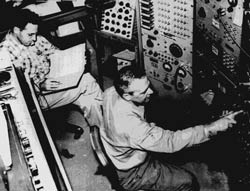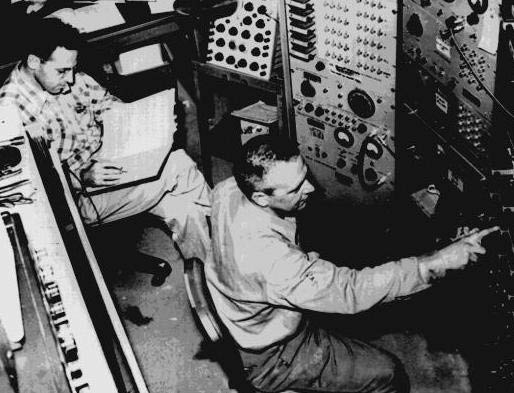Landmarks—Detecting the Elusive Neutrino
APS has put the entire Physical Review archive online, back to 1893. Focus Landmarks feature important papers from the archive.
The neutrino lived for a quarter of a century as a theoretical suggestion before its discovery in the 1950s, as reported in two Physical Review articles. Identifying the elusive particle required a detection system of unprecedented size, allied with ingenious data analysis, to pull a tiny signal out of a noisy background. The discovery of the neutrino, with roots in the wartime Manhattan project, marked the growing importance of “big science” projects that would increasingly dominate particle physics.
In 1930 Wolfgang Pauli proposed that an undetected particle–he called it the “neutron”–is emitted along with a positron in radioactive beta decay. This new particle would explain some puzzling aspects of the nuclear decay data. Enrico Fermi later called Pauli’s particle the “neutrino” to distinguish it from the now-familiar neutron, discovered in 1932. The neutrino was thought to rarely interact with other particles and so would be very difficult to detect.
In the early 1950s, Frederick Reines and Clyde Cowan of the Los Alamos National Laboratory in New Mexico designed a detector to identify neutrinos in the intense outburst of particles and radiation given off in a nuclear bomb test. But they abandoned that plan when they came up with a more sensitive scheme that could work with the smaller but steadier neutrino emission from a reactor.
Reines and Cowan focused on the reaction in which a neutrino hits a proton, creating a neutron and a positron. (In fact, the incoming particle is an antineutrino, but theorists didn’t yet know whether the neutrino and the antineutrino were distinct particles). A tank containing 300 liters of water supplied an abundance of protons. Any positron generated in the water would rapidly slow down and annihilate with an electron, producing a pair of detectable gamma rays.
But those detections would be enormously outnumbered by positrons created by other reactor emissions, as well as cosmic rays. In order to also detect the neutrons from neutrino-proton reactions, Reines and Cowan dissolved cadmium chloride in the water–at up to 40 kilograms per hundred liters. The water slowed down fast neutrons, allowing them to be captured by cadmium nuclei into an excited state that decayed by emission of an MeV photon. Only when this nuclear gamma ray followed an annihilation pair by a few microseconds would the experiment register a neutrino-induced event.
Using this “delayed coincidence” method at the Hanford Site in Washington state, Reines and Cowan announced a “probable” detection of the neutrino in 1953 in the Physical Review. They then moved to a more powerful reactor at Savannah River, South Carolina, where they used two 200-liter detection tanks surrounded by an even larger detection apparatus, and with better shielding of other reactor emissions. After amassing 100 days of running time, they announced in Science neutrino detections at a rate of 3 per hour [1] following up with a detailed account in the Physical Review in 1960.
Accepting a share of the 1995 Nobel Prize in physics (Cowan died in 1974), Reines remarked that before his and Cowan’s work, a “big” physics experiment might use a one-liter detector. It was their background in weapons research, suggests Francis Halzen of the University of Wisconsin, Madison, that emboldened Reines and Cowan to tackle such a large increase in experimental scale. Halzen, principal investigator of the planned IceCube neutrino observatory at the South Pole, recalls a conversation in which Reines emphasized how important it was that he approached neutrino detection with a theorist’s frame of mind–because a seasoned experimenter would have said there was no chance of success.
–David Lindley
David Lindley is a freelance science writer in Alexandria, Virginia.
References
- C. L. Cowan, Jr., F. Reines, F. B. Harrison, H. W. Kruse, and A. D. McGuire, “Detection of the Free Neutrino: A Confirmation,” Science 124, 103 (1956)





